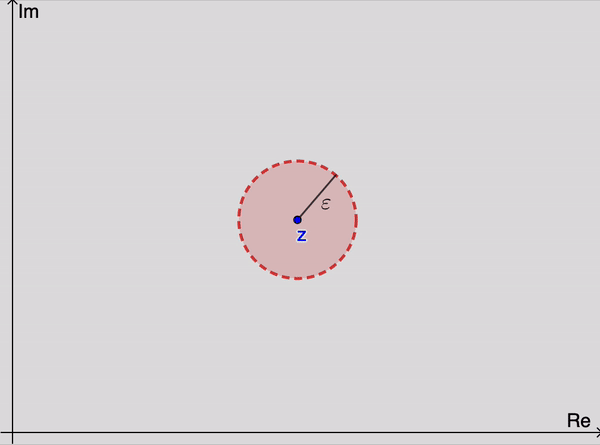5.1: Series
( \newcommand{\kernel}{\mathrm{null}\,}\)
Series
Convergence of Sequences
An infinite sequence {z1,z2,z3…} of complex numbers has a limit z if, for each positive number ε, there exists a positive integer n0 such that
|zn−z|<εwhenevern>n0.
Geometrically, this means that for sufficiently large values of n, the points zn lie in any given ε neighborhood of z (Figure 1). Since we can choose ε as small as we please, it follows that the points zn become arbitrarily close to z as their subscripts increase. Note that the value of n0 that is needed will, in general, depend on the value of ε.

The sequence {zn}∞n=1 can have at most one limit. That is, a limit z is unique if it exists. When that limit exists, the sequence is said to converge to z; and we write
limn→∞zn=z
If the sequence has no limit, it diverges.
Theorem 5.1.1
Suppose that zn=xn+iyn(n=1,2,3,…) and z=x+iy . Then
limn→∞zn=z
if and only if
limn→∞xn=xandlimn→∞yn=y.
- Proof
-
To prove this theorem, we first assume that conditions (3) hold. That is, there exist, for each ε>0, positive integers n1 and n2 such that
|xn−x|<ε2whenevern>n1
and|yn−y|<ε2whenevern>n2.
Hence if n0 is the larger of the two integers n1 and n2,|xn−x|<ε2and|yn−y|<ε2whenevern>n0.
Since|(xn+iyn)−(x+iy)|=|(xn−x)+(yn−y)|≤|xn−x|+|yn−y|,
then|zn−z|<ε2+ε2whenevern>n0.
Therefore condition (2) holds.Conversely, if we start with condition (2), we know that for each positive number ε, there exists a positive integer n0 such that
|(xn+iyn)−(x+iy)|<εwhenevern>n0.
However|xn−x|≤|(xn−x)+(yn−y)|=|(xn+iyn)−(x+iy)|
and|yn−y|≤|(xn−x)+(yn−y)|=|(xn+iyn)−(x+iy)|.
Consequently|xn−x|<εand|yn−y|<εwhenevern>n0.
Therefore, conditions (3) are satisfied. ■
Convergence of Series
An infinite series
∞∑n=1zn=z1+z2+z3+⋯
of complex numbers converges to the sum S if the sequence
N∑n=1zn=z1+z2+z3+⋯+zN(N=1,2,3,…)
of partial sums converges to S; we then write
∑∞n=1zn=S.
Note that since a sequence can have at most one limit, a series can have at most one sum. When a series does not converge, we say that it diverges.
Theorem 5.1.2
Suppose that zn=xn+iyn(n=1,2,3,…) and S=X+iY. Then
∞∑n=1zn=S
if and only if
∞∑n=1xn=Xand∞∑n=1yn=Y.
- Proof
-
To prove this theorem, we first write the partial sums (5) as
SN=XN+iYN,
whereXN=∑Nn=1xnandYN=∑Nn=1yn.
Now statement (6) is true if and only iflimN→∞SN=S;
and, in view of relation (8) and Theorem 1 on sequences, limit (9) holds if and only iflimN→∞XN=XandlimN→∞YN=Y.
Limits (10) therefore imply statement (6), and conversely. Since XN=X and YN=Y are partial sums of the series (7), the theorem is proved. ■
This theorem can be useful in showing that a number of familiar properties of series in calculus carry over to series whose terms are complex numbers.
Property 1: If a series of complex numbers converges, the n-th term converges to zero as n tends to infinity.
It follows from Property 1 that the terms of convergent series are bounded. That is, when series (4) converges, there exists a positive constant M such that
|zn|≤M for each positive integer n.
Another important property of series of complex numbers that follows from a corresponding property in calculus is the following.
Property 2: The absolute convergence of a series of complex numbers implies the convergence of that series.
Recall that series (4) is said to be absolutely convergent if the series
∞∑n=1|zn|=∞∑n=1√x2n+y2n(zn=xn+iyn)
of real numbers √x2n+y2n converges.
To establish the fact that the sum of a series is a given number S, it is often convenient to define the remainder ρN after N terms, using the partial sums:
ρN=S−SN
Thus S=SN+ρN. Now, since |SN−S|=|ρN−0|, then a series converges to a number S if and only if the sequence of remainders tends to zero.
Example 5.1.1
With the aid of remainders, it is easy to verify that
∞∑n=0zn=11−zwhenever|z|<1
We need only recall the identity
1+z+z2+⋯+zn=1−zn+11−z
to write the partial sums
SN(z)=∞∑n=0zn=1+z+z2+⋯+zN−1(z≠1)
as
SN(z)=1−zN1−z.
If
S(z)=11−z
then
ρN(z)=S(z)−SN(z)=zN1−z(z≠1).
Thus
|ρN|=|z|N|1−z|→0only when|z|<1.
In this case, it is clear that the remainders ρN tend to zero when |z|<1 but not when |z|≥1
Geometric series exploration
The series introduced in the previous example
∞∑n=0zn=11−zwhenever|z|<1
is known as the geometric series.
Use the following applet to explore this series. Drag the point z around. Observe what happens when it is inside, outside or on the border of the unit circle. Drag the slider to show the partial sum.
- Code
-
Enter the following script in GeoGebra to explore it yourself and make your own version. The symbol # indicates comments.
#Complex number Z = 0.72 + ί * 0.61 #Circle of radius 1 c = Circle((0,0), 1) #Number of terms of the partial series n = Slider(0, 250, 1, 1, 150, false, true, false, false) SetValue(n, 250) #Define the sequence z^n S = Join({0 + ί * 0, 1 + ί * 0}, Sequence(Z^j, j, 1, n)) #Define partial sum SP = Sequence(Sum(S, j), j, 1, n + 2) #Finally join the points of the partial sum L = Sequence(Segment(Element(SP, j), Element(SP, j + 1)), j, 1, n + 1)


